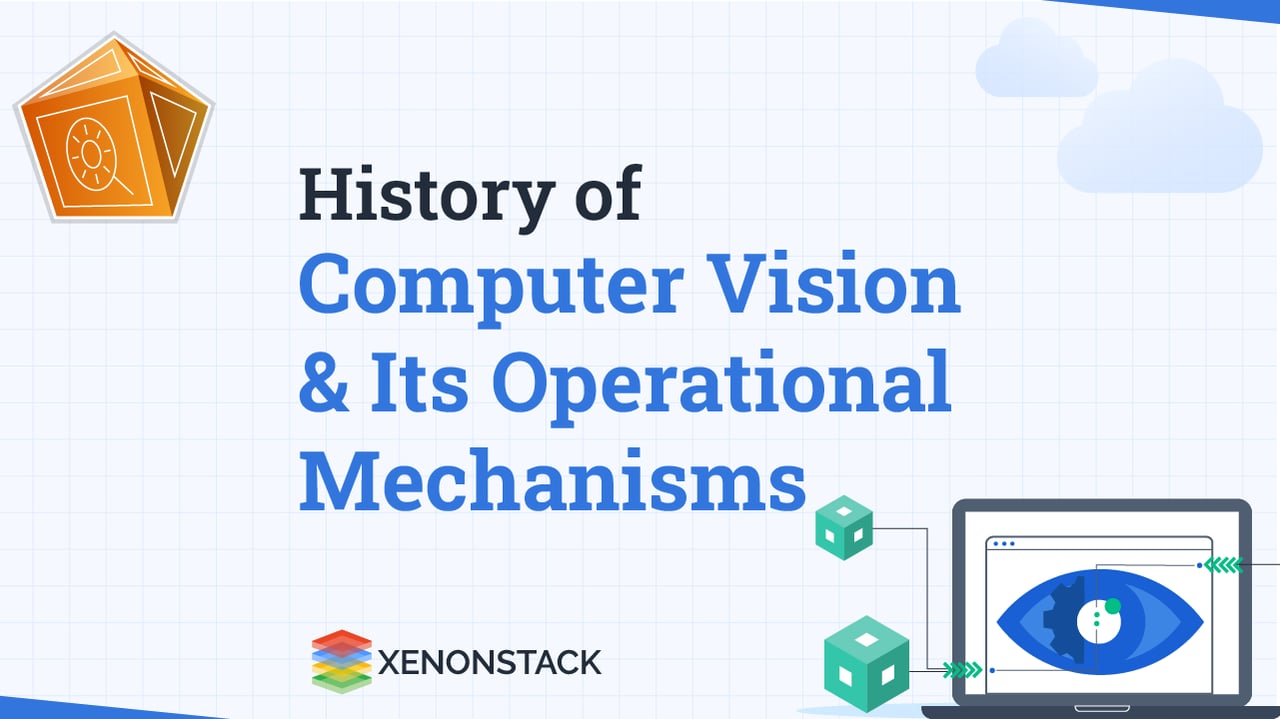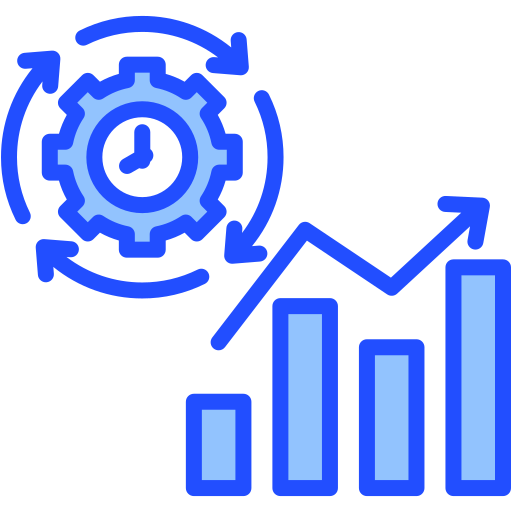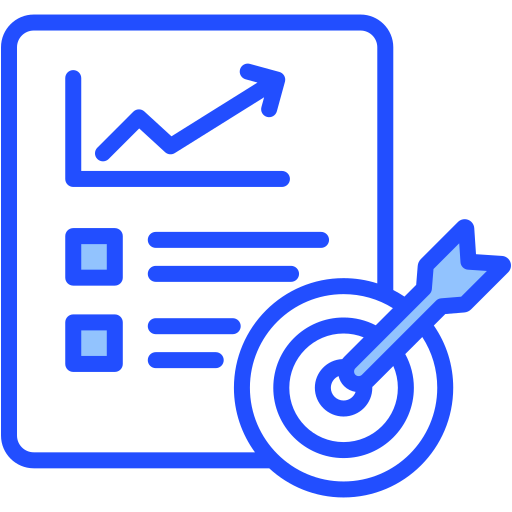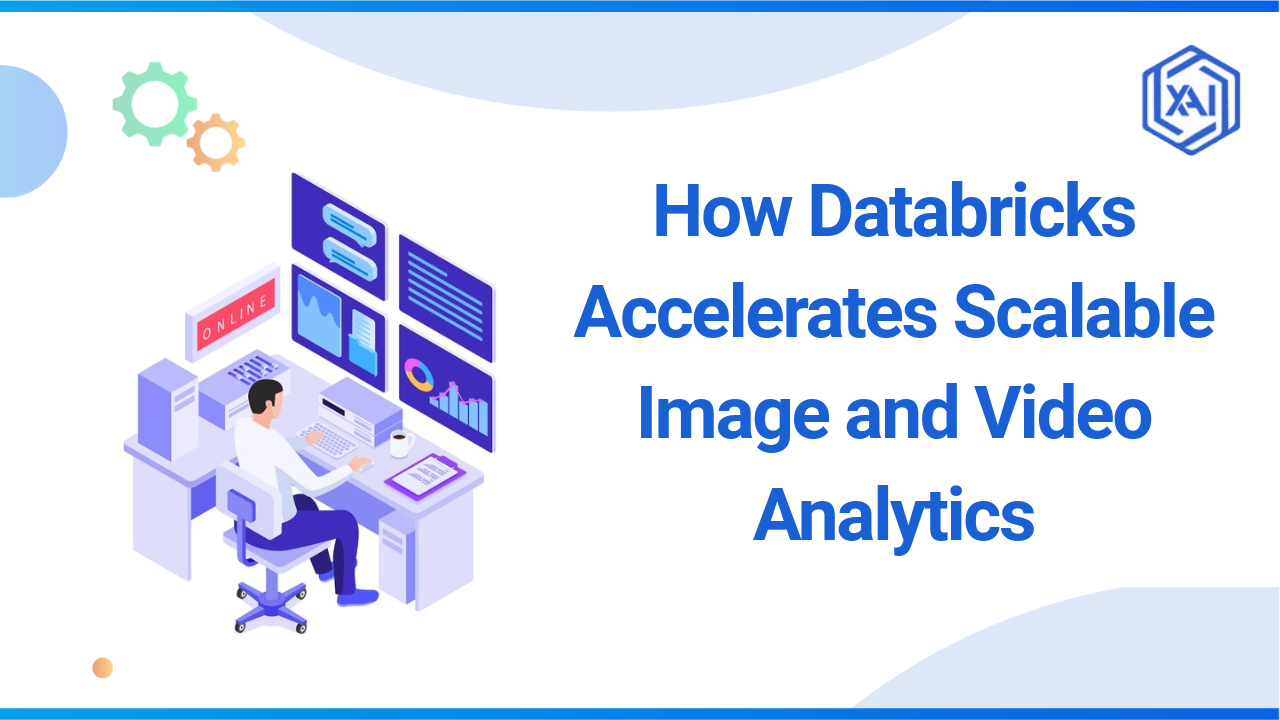
Understanding Computer Vision
Computer Vision (CV) is a sub-domain under the larger domain of Artificial Intelligence (AI), which is more focused on enabling machines or computers to understand and interpret visual data from digital images and videos. CV systems aim to make computers "see" and understand input from cameras or sensors, allowing them to process and analyze visual information similarly to human vision. The target of computer vision (CV) as a technology is to accredit robots, computers, machines, and bots to perceive visual stimuli and make informed decisions based on that data.
History of Computer Vision
Early experiments in computer vision began in the 1950s, with some of the first neural networks being used to detect object edges and categorize simple shapes like circles and squares. In the 1970s, the first commercial application of computer vision was optical character recognition (OCR), which interpreted typed or handwritten text, benefiting visually impaired individuals by converting written text into a readable format. By the 1990s, the rise of the Internet facilitated access to large sets of images for analysis, boosting the development of facial recognition programs, which allowed machines to identify specific individuals in images and videos.
Various factors contributed to the evaluation of computer vision
.png?width=512&height=512&name=cell-phone%20(1).png)
Mobile Technology
The extensive adoption of mobile devices equipped with cameras has inundated society with an abundance of photos and videos

Computing Power
The availability of computing power has significantly increased, making it more cost-effective and accessible for widespread use
.png?width=512&height=512&name=motherboard%20(1).png)
Specialized hardware
Specialized hardware designed for computer vision and analysis is now more accessible and widely available across various platforms
.png?width=512&height=512&name=artificial-intelligence%20(2).png)
Advanced algorithms
Innovative algorithms, particularly convolutional neural networks, can effectively utilize both hardware capabilities and software advancements
Natural Vision vs. Computer Vision
At the virtual end, computer vision (CV) aims to mimic human vision by allowing machines to perceive visual data meaningfully; it is still one of the most challenging areas of computer science. At the natural end, human vision, which is effortless even for children, involves interpreting a highly complex and ever-changing physical world. Computer vision (CV) tackles this ramification of providing vision to the machine/ computers, using advanced algorithms and AI models to approximate how humans see, recognize, and interpret visual input.
The Value of Computer Vision
Computer vision offers immense value across industries by performing tasks such as product inspection, infrastructure monitoring, and real-time defect detection. The veracity, agility, objectivity, and explainability of computer vision solutions allow machines/computers to outpace human capabilities in different scenarios. The current age of deep learning models (which eventually are also used in computer vision solutions) has reached, and in some cases exceeded, human-level performance in tasks like recognizing faces, detecting objects, and classifying various images, unlocking countless possibilities for automation and process optimization.
Benefits of Computer Vision for Different Sectors
Computer vision is rapidly transforming industries by automating complex visual tasks, reducing human error, and enhancing decision-making. Here are the key benefits of computer vision across different sectors:
Manufacturing: Automated Quality Control
-
Automated Defect Detection: CV systems can identify defects in products at a microscopic level, reducing the need for manual inspection and minimizing errors.
-
Increased Speed and Efficiency: Products are inspected at a much faster rate than human workers, accelerating production lines.
-
Cost Savings: Here is the reference to those activities that can save costs, e.g., reducing rework and waste due to early defect detection lowers operational costs.
Retail: Enhanced Inventory Management
-
Smart Shelf Management: CV-enabled shelves can automatically track inventory levels and notify staff when restocking is needed.
-
Cashier-less Checkout: Computer vision systems can detect and track items picked up by customers, allowing for seamless, automated billing processes.
-
Customer Behavior Insights: CV analyzes customer movements and behaviors in-store, helping retailers optimize product placement and improve sales strategies.
Healthcare: Improved Diagnostics and Monitoring
-
Automated Medical Imaging Analysis: CV algorithms can detect abnormalities in X-rays, MRIs, and CT scans, assisting radiologists with faster, more accurate diagnoses.
-
Real-time Patient Monitoring: CV systems can track patient vitals and movements, alerting healthcare providers to potential issues.
-
Early Disease Detection: AI-powered CV tools can identify diseases in their early stages, improving patient outcomes through timely interventions.
Agriculture: Optimized Crop Management
-
Drone-based Monitoring: CV-enabled drones can survey large farmland areas, detecting crop health, pest infestations, and irrigation needs in real-time.
-
Yield Prediction: CV systems analyze crop conditions and offer accurate predictions of potential yields, allowing farmers to optimize resource usage.
-
Precision Farming: Computer vision helps farmers apply fertilizers, pesticides, and water precisely where needed, minimizing waste and improving efficiency.
Automotive: Autonomous Driving and Safety
-
Autonomous Vehicle Navigation: Computer vision enables self-driving cars to detect obstacles, pedestrians, and other vehicles, ensuring safe and efficient navigation.
-
Advanced Driver Assistance Systems (ADAS): Computer Vision (CV) based systems offer lane-keeping assistance, collision avoidance, and traffic sign recognition, enhancing driver safety.
-
In-vehicle Monitoring: CV tracks driver fatigue and distractions, triggering alerts to ensure safer driving conditions.
Construction: Site Monitoring and Safety
-
Real-time Site Monitoring: CV systems can monitor construction sites in real-time, identifying safety hazards and ensuring compliance with regulations.
-
Progress Tracking: CV enables automatic tracking of construction progress, comparing actual work to project timelines and detecting delays early.
-
Worker Safety: CV systems detect unsafe worker behaviors or conditions and send alerts to prevent accidents, improving site safety.
Transportation and Logistics: Efficient Operations
-
Traffic Management: CV-powered cameras analyze real-time traffic flows, optimizing signal timing and reducing congestion in smart cities.
-
Automated Vehicle Inspection: Computer Vision solutions, such as CV systems, check vehicles for damage or maintenance needs, reducing manual inspection times and ensuring fleet safety. Here, Generative AI can also be combined with computer vision to create virtual agents, such as Vision agents.
-
Package Sorting: In logistics, CV automates the sorting and tracking of packages, accelerating the shipping process and reducing errors.
Security and Surveillance: Enhanced Threat Detection
-
Real-time Threat Detection: CV systems monitor video feeds in real-time, detecting suspicious activities and triggering alerts for potential security threats.
-
Facial Recognition: Computer vision enables accurate facial recognition for access control and identity verification in sensitive areas.
-
Crowd Monitoring: CV systems can analyze crowd behaviors and movement patterns, identifying anomalies or potential safety risks in large public spaces.

Figure: Percentage of different practical applications driving adoption in various industries
For more applications, check this out - Top 10 Computer Vision Applications with Gen AI and Agentic Workflows
Computer Vision at the Edge
Computer vision at the edge leverages the combined advantages of cloud computing and on-device processing to create scalable and flexible solutions. A combination of Computer vision (CV) solutions running on edge devices results in a decrement in the need for data offloading and centralized image processing in the cloud, enabling real-time applications without relying heavily on network connectivity. This is especially crucial in video analytics, where low latency and bandwidth usage are essential. Computer Vision with Edge devices provides the platform for developing secure, private, and mission-critical solutions, with reduced dependencies on network and connectivity, which further makes these solution ideals for industries requiring robust and efficient solutions.
Why Industries are Turning to Computer Vision

Automation and Efficiency
Computer vision enables automated processes, such as quality control and real-time monitoring, reducing human intervention, increasing operational speed, and minimising errors

Enhanced Accuracy and Precision
Computer vision enables automated processes, such as quality control and real-time monitoring, reducing human intervention, increasing operational speed, and minimising errors
How does Computer Vision transform businesses?
Computer vision (CV) helps different organizations or businesses with tasks like automating critical functions, making better decisions, and eventually enhancing overall accuracy.
Industries such as manufacturing, healthcare, retail, and security are leveraging computer vision to modernize traditional workflows and drive innovation. But how computer vision resulting this change, let us look at some essential elements that, when combined with computer vision, play a significant role in transforming businesses:
 Figure: Applications that can help computer vision to transform the business
Figure: Applications that can help computer vision to transform the business
Enhancing Operational Efficiency
Computer vision (CV) provides vision to machines, bots, and computers. It (computer vision) is a powerful tool for enhancing the efficiency of different operations, which further leads to automating processes, reducing errors, and streamlining workflows. Here are key strategies for optimizing operations with computer vision integration:

Figure: Different factors that can affect the strategy of enhancing operational efficiency with computer vision
Reducing Manual Workloads
Computer vision (CV) is transforming how businesses operate by automating a wide range of manual workflows, reducing human intervention, and increasing operational efficiency. By enabling machines to “see” and interpret visual information, CV creates new opportunities for automating repetitive, labor-intensive tasks, allowing companies to streamline operations and reduce errors. Here’s how computer vision is revolutionizing various sectors by reducing manual workflows:
Image Recognition and Classification
At the heart of many computer vision solutions is image recognition and classification. These technologies allow machines to:
-
Identify objects, people, or scenes in images and videos,
-
Categorize items based on visual characteristics,
-
Detect defects or anomalies in manufacturing processes.
Real-time Monitoring and Analysis
Computer vision also plays a critical role in real-time monitoring and analysis of visual data streams, optimizing tasks such as:
-
Quality control in production lines,
-
Security surveillance and threat detection,
-
Traffic monitoring and management.
Autonomous Navigation
In industries that rely on autonomous systems, such as self-driving vehicles, warehouse robots, and drones, computer vision is indispensable. These systems rely on the CV to interpret their surroundings and navigate autonomously, reducing the need for manual operation. As a result, businesses can deploy autonomous vehicles and robots that operate continuously without the limitations of human labor, reducing labor costs and increasing operational uptime.
Document Processing and Data Extraction
Computer vision techniques can automate document processing and data extraction, significantly reducing manual workflows. For example:
-
Optical character recognition (OCR) automates the digitization of printed or handwritten text,
-
Automated form processing and data entry speed up administrative tasks,
-
Invoice and receipt parsing streamlines financial automation.
Gesture and Behavior Recognition
In contexts where human-machine interaction is crucial, computer vision enables gesture and behavior recognition. These systems can automate:
-
Touchless interfaces for hygiene-sensitive environments,
-
Automated customer service interactions, providing smoother user experiences,
-
Safety monitoring in industrial settings, ensuring workplace safety through behavior analysis.
AR applications powered by computer vision are making significant strides in automating and enhancing workflows. Examples include:
-
We can take examples of the solutions that are used to provide guidance (optical and visual guidance) for assembly tasks or maintenance tasks in industrial settings,
-
Overlaying relevant information on physical objects to assist in tasks like equipment repair,
-
Facilitating remote expert assistance in complex procedures.
Reducing Manual Workflows Across Industries
-
Retail and Inventory Management: Smart shelves with CV-enabled cameras can automatically track inventory levels, notifying staff when items need replenishment. In cashier-less stores, computer vision tracks customer selections and automates billing, eliminating the need for manual stock checking and cashier operations.
-
Manufacturing and Quality Assurance: In manufacturing, computer vision inspects products on production lines with unparalleled speed and accuracy. It can detect flaws that are invisible to the human eye, significantly reducing the need for manual inspection and rework, which helps lower operational costs.
-
Construction operations and Infrastructure tasks: Computer vision enhances construction operations-related workflows by providing solutions that can automate safety monitoring and project progress tracking. For example, AI-driven image recognition can automate the marking of reinforcing bars, reducing labor costs and improving precision.
-
Agriculture and Crop Management: Farmers use CV-enabled drones to monitor large areas of farmland, automating tasks like pest detection and crop health analysis. This automation allows farmers to respond quickly to potential issues, reducing manual field inspections and improving resource management.
-
Healthcare and Medical Imaging: In healthcare computer vision is used in medical imaging to detect abnormalities in X-rays, MRIs, and CT scans. This reduces the need for radiologists' manual analysis and enables faster, more accurate diagnoses, improving patient care and operational efficiency.
Let us look case of an industry where computer vision is helping - Computer Vision in Supply Chain Management | A Detailed Guide
How Does Computer Vision Work?
Computer vision (CV) is the process of enabling machines and computers to understand visual information from the world around them, much like human vision. It involves capturing, processing, and analyzing visual data to make intelligent decisions based on the information contained in images or video. To understand how computer vision works, it's essential to explore the key technologies driving this field and the workflow of a typical computer vision system.
Key Technologies Behind Computer Vision
Image Processing
Image processing is the foundation of computer vision. It involves transforming raw images into a more manageable form by applying filters, enhancing image quality, and extracting relevant features. Techniques such as edge detection, noise reduction, and segmentation help highlight specific objects, regions, or patterns within an image.
Machine Learning
Machine learning algorithms are vital in training computer vision systems to recognize objects and patterns. Using large datasets of labeled images, machine learning models can "learn" to identify and classify objects by detecting underlying patterns in the visual data. Machine learning and Deep learning algorithms, such as Random Forest, decision trees (DT), support vector machines (SVM), and k-nearest neighbors (KNN), are some of the early examples of machine learning in CV.
Deep Learning and Neural Networks
The advent of deep learning, particularly convolutional neural networks (CNNs), has revolutionized computer vision. CNNs are specialized algorithms that mimic how the human brain processes visual information, breaking images into smaller pieces and analyzing these fragments to recognize objects and patterns. Deep learning models are trained on massive datasets and can outperform traditional machine learning methods in complex tasks like facial recognition, object detection, and image classification.
Optical Character Recognition (OCR)
OCR is a technology used to extract text from images, making it possible for computer vision systems to digitize printed or handwritten content. OCR is widely used for automating tasks like document processing, scanning invoices, and parsing written data into machine-readable text.
3D Imaging and Sensing
In addition to 2D image analysis, computer vision systems often use 3D imaging technologies like LiDAR (Light Detection and Ranging) and depth sensors to capture spatial data. This can be considered crucial or important in solutions and applications such as autonomous vehicles (where understanding the distance and dimensions of objects in the environment is essential for navigation and safety). It can also be used in other different use cases and solutions, like increasing precision in different development processes, e.g., mechanization of different manual processes.
Conclusion: The Transformative Potential of Computer Vision
Computer vision (CV) transforms industries by enabling machines to analyze and interpret visual data, automating processes, and improving decision-making. Evolving from simple shape detection to advanced applications like facial recognition and autonomous driving, CV now plays a vital role in sectors such as healthcare, manufacturing, and security. Powered by deep learning and integrated with IoT and edge computing, CV enhances operational efficiency, reduces errors, and drives innovation. As its applications continue to expand, CV is poised to be a key driver of future technological advancements across industries.




